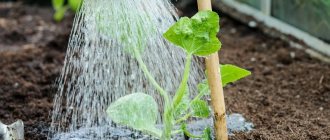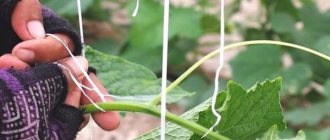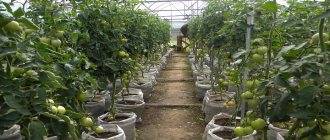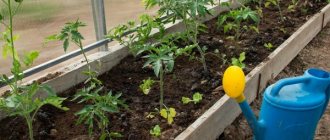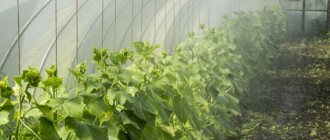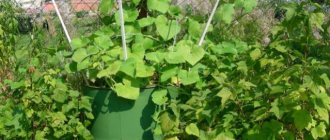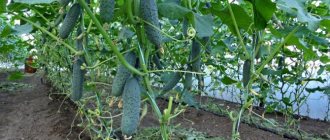Growing cucumbers in a polycarbonate greenhouse is not an easy task, but it is profitable. In order for the harvest to be abundant and the fruits to be healthy and juicy, you will have to work hard. Today we will talk about how to grow cucumbers and how suitable a plastic greenhouse is for this.
Growing cucumbers in a polycarbonate greenhouse
Pre-landing preparation
When buying seeds, look on the packaging for information about what kind of pre-treatment they have undergone. If there is no information, it is recommended to do it yourself.
Checking the quality of seeds with salt water
Seeds
We start with calibration - selecting the material most suitable for planting. This is definitely worth doing when the seeds are from the market or prepared on your own. Store-bought ones are calibrated before packaging, so they do not require additional selection. So:
- Step 1: select the largest, evenly colored, light and even seeds;
- Step 2: get rid of deformed specimens, as well as dark, small and stained specimens.
Alternative option:
- Step 1: To facilitate the process, pour the contents of the bag into a solution of table salt (3 g per half glass of water) and mix. After 15 min. specimens will surface that are better to part with. The method is suitable for seeds that are not older than 2 years. “Sunken” material is what you need.
- Step 2: Remove it and immerse it in a 1% manganese solution, rich purple in color, for half an hour to disinfect. Afterwards we rinse with water.
Antimicrobial treatment can also be carried out using special preparations such as Baksis and Fitosporin-M. Any of them is diluted with water and the seeds are poured for 1.5-2 hours, after which they need to be dried.
Important! There is also a method called soaking. It speeds up the emergence of seedlings, but washes away the antibacterial layer that covers store-bought seeds. In addition, a decrease in soil temperature, as well as its dryness, can be detrimental to “wet” seeds. For this reason, the method is suitable for growing seedlings indoors, but is not recommended before sowing directly into the garden bed, when warm weather has not yet established.
Prices for Fitosporin
Fitosporin
The soil
It also needs preparation, since the volume and quality of the harvest largely depend on the characteristics of the soil, which should:
- be characterized by high fertility;
- have good moisture absorption capacity;
- give a neutral acidity indicator.
Prepared soil is the key to a rich harvest.
The optimal soil is considered to be one that contains peat, field soil and humus in a ratio of 5:2:3. Experienced gardeners advise adding pine sawdust.
The soil must be cleared of roots and grass, and also disinfected. To do this, use a 7% solution of copper sulfate.
Important! It is believed that cucumbers grow best in beds whose height is 0.25 m, and the surface is formed in the form of alternating ridges.
When to plant
As soon as the seedlings have produced 3-4 leaves, they are transferred to the greenhouse. It is better to do this in May. It is not dangerous to place seedlings in a polycarbonate greenhouse even in the first days of the month. It is important that the day is warm (about +25°C) and sunny. If it is cool outside, the greenhouse will have to be heated artificially.
With the onset of warm weather, the seedlings are transferred to the greenhouse.
Protection from diseases and pests
General prevention in the greenhouse against pests and diseases is as follows:
- removal of vegetation and weed residues from the greenhouse;
- compliance with crop rotation;
- removal of dry leaves, rotten fruits;
- mowing weeds near the greenhouse;
- disinfection of greenhouses;
- loosening the earth;
- timely addition of bait;
- maintaining the required temperature and humidity;
- inspection of seedlings before planting.
To prevent the appearance of parasites and diseases in the greenhouse, it is necessary to periodically apply chemical sprinkling. There are many pest control products available in stores.
How to plant
Seeds are most often sprouted in pots or paper cups. To fill them, peat is added to sawdust in a ratio of 1:3 and mixed with vermicompost. The acidity level of the mass is desirable in the region of 6-6.5, and the depth of the holes is 2 cm. If you maintain the temperature at 24-25°C, seedlings will become noticeable after a week. They are not watered for a couple of days after their appearance. Growing full-fledged seedlings will take 25 days.
Paper and plastic containers are suitable for germinating seeds.
Soil prepared in autumn and spring:
- pour a hot solution of potassium permanganate, pink;
- Cover with film for 3 days;
- open and form a bed with holes arranged in a checkerboard pattern. The depth of each should be equal to the height of the glass with seedlings, and a little fertilizer is placed at the bottom.
Seedlings are placed not only in a regular bed, but also in a potato “pie”. The peel of the starchy vegetable is dried and ground, and before planting the cucumbers, it is soaked in plain water. The resulting mixture is poured into the hole, sprinkled with earth, and then the potato mixture is poured again. The shoots are planted in this “pie”.
Important! After transferring the seedlings to the greenhouse, regardless of the method of growing it, it is necessary to monitor the condition of the leaves. It is better to remove plants with signs of pale color immediately, as there is a high probability that the problem is a disease. If this is not done, you may lose all the seedlings. Disinfection of the greenhouse, which is carried out on the eve of planting and at the end of harvest, will help reduce risks.
Another reason for pale leaves is considered to be low soil temperature. Sometimes it is possible to correct the situation by watering with warm water with a small amount of potassium permanganate. To prevent the soil from cooling down during cold weather, it is recommended to warm up the air in the greenhouse.
Pale leaves on cucumbers
Peat prices
peat
Preparing soil in a greenhouse
Cucumbers love loose and fertile soil. This is what fertile loams are. Clay is too heavy for them and lacks breathability. The sand is loose, but it does not hold water, and without it, cucumbers will not grow. As a last resort, sandy loam is suitable, to which you can add a little heavy clay soil to balance the composition.
In a greenhouse, you need to prepare the soil in advance. You can plant green manure immediately after harvesting vegetables, and dig up with them before frost. The best option would be mustard greens. It will disinfect the soil and enrich it with valuable microelements.
With the onset of winter, you need to throw snow into the greenhouse so that in the spring moisture saturates the soil. After all the snow has melted, the soil in the greenhouse is dug up. The holes must be prepared in advance before planting seedlings. The ideal option is warm ridges, because cucumber is a very heat-loving crop.
They can be made both in autumn and spring. If this is not possible, then humus or compost mixed with ash and double superphosphate is placed in the prepared furrows or holes: half a glass of superphosphate and a liter of ash per bucket. Then sprinkle with 10-20 cm of loose soil.
If you change the soil in the greenhouse in the fall or spring, then you should take into account that you need to take the soil from those areas where the day before you grew vegetables that do not have common diseases with cucumbers: cabbage, onions, carrots, peppers or potatoes.
What are the benefits of a polycarbonate greenhouse?
Its advantage is that:
- the cellular structure of the material transmits light and retains heat, and also allows you to create and maintain a microclimate that is optimal for the growth and ripening of cucumbers;
- ventilation occurs due to the flow of air, without overcooling the plants and the risk of sunburn of the leaves;
- the structure is not dismantled for the winter, as it normally tolerates the cold season, as well as the heat.
You can read more about polycarbonate greenhouses in our article.
In a polycarbonate greenhouse, seedlings are not afraid of temperature changes.
Important! An additional advantage is that you can grow a crop of excellent cucumbers in a plastic greenhouse not only using seedlings, as in open ground, but even through seeds.
How to choose a polycarbonate greenhouse
Growing conditions
In order for cucumbers to enjoy a bountiful harvest, it is important to provide the necessary growth conditions, including:
- Feeding. It is important to remember that there should not be more than 4 of them per season.
- The right climate. Ventilate the greenhouse not only on sunny days, but also on cloudy days, otherwise the plants will become sick due to excessive air humidity.
- Loose soil. It should be crumbly, soft and allow air to reach the roots.
- Mulching. Sawdust, like dried grass without roots and seeds, will prevent moisture from evaporating too quickly, and will also protect ripe fruits from contact with the ground and subsequent rotting. In addition, mulch is sprinkled on exposed roots.
The correct watering and fertilizing regime are important conditions for growing cucumbers.
- Proper watering. A ripe cucumber consists of more than 90% moisture, so it needs a lot of water during the growth process.
- 3-4 days after planting, water only the lower part of the plant for half a month to help the development of normal roots. Flooding is not recommended to avoid rot;
- Until the day the first ovary appears, frequent moistening is not required; once every few days is enough. Once the ovaries appear, watering should be daily, using settled water. It should not be directed at the leaf plates, so as not to provoke rotting or burns through the drop lenses;
- the use of low-temperature moisture can cause the ovaries to fall off.
Vegetable growers recommend:
Important! If you put water in buckets in advance and leave it near the bed with cucumbers, by the time of watering it will have time to warm up, and the air in the greenhouse will never be dry.
The correct garter is also important. The twine is tied around the plant in a loose loop and left. If pulled tight, it will be difficult for the stem to gain thickness. As the vine grows, it is led around the rope, always pointing in one direction.
Advice from experienced gardeners
It is especially difficult for beginners to properly care for crops, and mistakes often lead to crop loss due to disease or unsuitable conditions. Experienced gardeners usually have their own secrets that help them grow healthy and strong cucumbers:
- The correctly selected variety largely determines the success of further growing cucumbers in a greenhouse; select varieties specifically designed for indoor soil.
- Maintain a constant temperature in the greenhouse using ventilation, automatic ventilation systems, additional heating, infrared lamps, and hot water containers. The crop should not be stressed by temperature fluctuations.
- When growing bee-pollinated varieties, it is necessary to create air circulation inside the greenhouse at the time of flowering by opening the windows and doors. To attract insects, you can bait with honey water. Shake the vines to mix the pollen in the morning.
- You cannot loosen the root zone of cucumbers, since the roots of the crop are located superficially. Instead of loosening the soil under the plants, cover it with a mulching layer of straw, dry grass, peat or humus.
- The acidity of the soil when growing cucumbers should be neutral. Slaked lime or dolomite flour is added to soil with an excessively acidic reaction. When alkalizing the soil, it is spilled with a solution of boric acid (1 tablespoon per bucket of water).
- Be sure to weed out weeds so that they do not take away the strength of cultivated plants.
- Overripe fruits can be used to obtain seeds, leaving the largest cucumber to ripen in the sun. After it turns completely yellow, the pulp and seeds are dipped in a glass for two days, then the seeds are washed in a colander and dried. Store the seed material in a dry place, placing it in a paper envelope or linen bag.
How to form lashes and is it always necessary?
The greenhouse should not resemble a jungle. Dense thickets are predictable when the gardener did not take care of the timely formation of the vegetable. To avoid getting a forest of cucumber grass instead of a harvest, you need:
- Find the first three true leaves and remove the buds and shoots from them. This will give impetus to the growth and formation of a large number of ovaries.
- At a height of up to half a meter, break off the side shoots completely, leaving each of them with a single leaf over the next 50 cm. Three leaves are left at a distance of 100 to 200 cm from the root.
- All lateral mini-shoots found on the second row must be pinched onto one leaf. The taller the plant is, the greater the number of shoots allowed. We throw the main trunk over the trellis and pinch it again, leaving 40 to 60 cm.
A proper greenhouse with cucumbers does not look like a tropical forest.
Table 1. Requirements for the formation of lashes in cucumbers of different varieties.
| The need for manipulations to form a bush | general characteristics | Variety |
| Frequent | Hybrids prone to forming a large number of branches, bred for cultivation in a greenhouse. | Moscow greenhouse; Yuventa and Rodnichok; Epic and Ritual; Topolek and Vilina; Malachite and NIIOH 412. |
| Rare | Hybrids with little branching on the sides. | Zozulya and the Golden Cockerel; April and Understudy; Gribovchanka and TCXA 3707. |
| Absent | Varieties with flowers in one ovary. | Brigadier and Neroshimy; Muromsky and Libelle; other. |
Soil quality and breathability
Always make sure that the soil for cucumbers in the greenhouse is loose and saturated with oxygen. The easiest way to achieve this is to add sawdust or finely chopped straw every spring, which must be prepared in the fall. But after this procedure, be sure to add nitrogen fertilizers, because it is known that sawdust and straw bind nitrogen into a form inaccessible to plants. By the way, crushed tree bark, humus and top peat are also well suited as loosening materials.
Here are the best soil recipes for a greenhouse with cucumbers:
- 1 part each of peat, humus, turf soil and sawdust.
- 6 parts peat with 2 parts humus and 2 parts sawdust.
- 2 parts turf type soil, 3 parts peat, 3 parts humus and 1 part sawdust.
- 5 parts turf type soil, 1 part peat and 1 part humus.
Make the beds 80 cm wide, 35 cm high and 60-70 cm wide. Before planting seedlings, spread fertilizer over the beds: 1 tbsp. a tablespoon of potassium sulfate + 1 teaspoon of urea + 1 tablespoon of superphosphate + 1 glass of ash.
As the cucumber grows, the roots of its plant are gradually exposed - cover them with moistened soil in time.
Male and female flowers: what is the difference and what are they needed for
Their main difference is that the former have stamens, but are barren flowers, while the latter lack pollen, but produce ovaries. Pollination is necessary for fruit formation, so both “girls” and “boys” are needed. At the same time, when there are too many “guys”, their number can be reduced.
Active formation of female flowers occurs at the beginning of the vegetative process, especially if the temperature is slightly reduced. Smoke also contributes to their appearance, so vegetable growers periodically “smoke” the beds.
Male and female cucumber flowers.
There are always more male inflorescences on the main stem than on the lateral ones. Their number increases with abundant watering, as well as in the case of growing seedlings from seeds of last year's harvest. Planting density also matters: when there are more than 5 plants per square meter, the percentage of male flowers increases.
The nuances of pollination
Among the many cucumber varieties and hybrids, there are those that pollinate independently or do not need it at all. The latter include parthenocarpic varieties that do not form seeds and therefore reproduce vegetatively.
Today we’ll talk about pollinated varieties and how to influence the process. Luring bees into a greenhouse is not as easy as it seems. They are not too attracted to the smell of heated polycarbonate, so gardeners use bait. One of these is water with leftover jam or a small amount of honey. The beds are sprayed with it and the greenhouse windows are left open.
Winged pollinator of cucumber flowers.
If the bees are in no hurry, you can pollinate the plants yourself. To do this, take a fluffy brush and transfer pollen from male to female flowers. There is an alternative way:
- pluck an inflorescence that has no signs of an ovary at the base;
- The petals are carefully torn off, and the stamens are placed on the stigma of a flower of the opposite sex. It is better to perform the manipulation early in the morning, using several male specimens at once for reliability.
Important! Before pollination, you should make sure the pollen is ripe. To do this, use a simple test: touch the back of the hand with the flower stamens. If the yellowish dust remains on the skin, you can start.
Problems likely to occur when growing cucumbers
There are several of them. Let's consider each separately, as well as the reasons and possible solutions. So:
The branches of the lower part are drying
This happens due to lack of moisture in hot summers. Compared to the problems with the lower tier, the upper one looks quite normal and even pleases with the ovaries. We proceed as follows:
- little by little, day by day, remove the leaves from below;
- roll the stem into a ring and lay it on the ground;
- carefully “fasten” it to the ground with a wire fork so that the top, with all the leaves and flowers, remains higher;
- We provide watering and maintenance.
In diseased plants, the ovaries turn yellow and fall off long before they fully ripen.
After a while, the deep part of the stem will begin to grow a root, and everything will return to normal.
Ovaries do not form
Bundle varieties of cucumbers, like hybrids, produce abundant harvests. Each node contains up to 7 ovaries, but some may turn yellow and fall off before they begin to grow. There are several reasons for this:
- too humid and/or hot;
- there are less than 10% male flowers on the bush;
- a large number of ripe fruits on the vines;
- insects do not arrive and pollinate plants due to bad weather;
- few nutrients in the soil.
The first problem can be solved by reducing watering and ventilation. The last one is feeding with a mixture of cow dung and urea, and when it comes to adult cucumbers, you just need to remove them on time. This is done daily as the fruit grows.
Important! Do not allow cucumbers to grow more than 12 cm in length and 5 cm in thickness. When the lashes are covered with green giants, all the nutrition goes to them, so new ovaries are not formed.
Fruits grow poorly
A “poultice” will help: on a sunny day, water the greenhouse, as well as the plants and soil, and then close it for an hour. Ventilate carefully, without drafts.
Poultices should be used with caution.
Bitter taste
This happens even with normal watering, and the culprit is the substance cucurbitacin, which is responsible for the taste. Its volume in a vegetable is determined by growing conditions, characteristics of the variety, and duration of ripening.
Important! The longer the period from pollination to a full-fledged cucumber (the norm is 8 to 12 days), the more bitterness it will contain.
Watering on schedule
You will be interested to know that the real ancestors of the modern cucumber came from the jungle, and these fruits were very bitter. And all because they grew too crowded, and they ended up lacking either moisture or nutrients. Try to repeat this experiment on your own plot and with ordinary seeds - the result will be the same, believe me. Haven’t you ever bought beautiful, but very bitter cucumbers at the market?
Before flowering, water greenhouse cucumbers once every 5-7 days, and after flowering - every 2-3 days. After all, it is during this period that the fruits begin to “pour,” as people say. Normal watering of cucumbers in a polycarbonate greenhouse is 1-2 buckets per 1 m2. Even if you are very busy, still do not water the cucumbers with cold water - this will cause powdery mildew to appear on the leaves and the plants will die. Just don’t water the cucumbers with a hose - strong pressure will wash away the soil, and this, in turn, will damage the root system.
To prevent the plant from growing too actively upward and taking all the moisture and nutrients, just pinch it:
